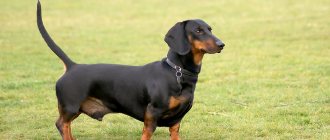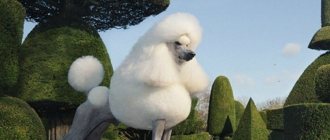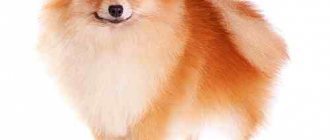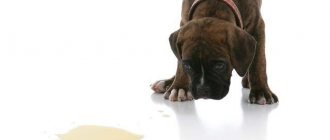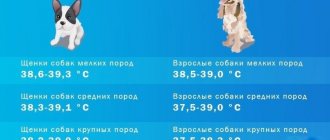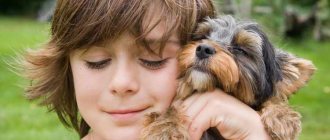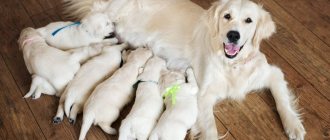To maintain a neat appearance of the animal, dogs periodically need to do trimming - this is plucking out dead remnants of fur. The coat of any dog is unique, but according to the general classification, all breeds can be divided into three types: wire-haired, short-haired and long-haired. The first type does not have a natural molting process.
The need for trimming for a dog
The extent to which it is necessary to remove the old coat can be determined by understanding its structure. In dogs, especially hunting breeds, during the process of evolution, the fur was divided into two layers. The lower one, adjacent to the skin, is soft and thick, protects from cold, parasites, and moisture. External - forms a kind of shell that reflects the attacks of winds, sharp branches and opponents.
Since pets are not exposed to aggressive environmental influences, the outer coat remains intact. Over time, it rolls down and turns into a dense, airtight cocoon. If the animal is not trimmed, after a few weeks diaper rash begins to appear on the skin, redness, itching and irritation occur, and infectious diseases caused by pathogenic flora develop.
With proper care, the dog's coat becomes clean and acquires a healthy, shiny appearance. Blood circulation in the skin improves, positively affecting all body systems and the pet’s mood.
Dog trimming tools with descriptions
Before carrying out the event at home, you need to familiarize yourself with the list of tools for trimming dogs.
- Table. The dog should not feel uncomfortable. A rough surface will do. The owner should also be comfortable.
- Trimming knife. This tool was created specifically for wire-haired four-legged animals and has replaceable blades. Stainless steel will protect against infection. The blades pinch the undercoat and thick hair.
- Cleansing stone. It is used after pinching. The purpose of the stone is to remove the remains of dead hairs. Reminds the action of pumice.
- Knife made of stone. Used for places that are difficult to reach, such as the ears.
- Brush. This tool must be stiff in order to thoroughly comb out the hairs that have been plucked.
- Chalk (powder). Used on the skin for disinfection.
- Thimble. To protect the groomer. Some people pluck the fur with their bare hands, but the procedure is lengthy and it is better to be on the safe side.
Useful tips
Finally, you should pay attention to the following tips that will help the pet and its owner survive trimming with dignity:
- the first procedure will have to be carried out in stages, allowing the animal to rest from new sensations;
- manifestations of nervousness and dissatisfaction on the part of the pet should not be ignored; it is better to distract the dog from this state, for example, with a massage; after some time you can continue the procedure;
- There is no need to bathe before trimming; clean fur becomes smooth and silky, making it more difficult to remove;
- After trimming, the dog should be rinsed well with warm water, which will remove any remaining old hair and prevent the development of skin irritation.
- If trimming is carried out in the cold season, then the dog will have to be dressed for walks.
In the next video you can watch how to properly trim a fox terrier.
Types of trimmers
So, in stores you can find the following types of dog trimmers:
- vibration;
- pendulum;
- rotary;
- rechargeable.
Groomers usually use the last two types of clippers and very rarely vibrating ones, since they have low productivity and it is difficult to replace the knife on these clippers.
Pendulum ones are quite complex for home use. Rotary ones are the most powerful, they can be used for cutting dogs with very thick and coarse hair.
Sometimes, they have a cooling system, which allows you to do a haircut for a long time without stopping. If you are the owner of a not very fluffy dog, you can purchase a battery-powered one. It will easily remove unwanted hair, while it is lightweight and convenient because you are not tied to an outlet in any way and the cord will not interfere with you during the cutting process.
In addition, when choosing a trimmer, pay attention to its size. If you have a small dog, then, accordingly, take a small trimmer that will allow you to reach hard-to-reach places. You also need to check the level of noise produced; your pet may be frightened by loud sounds.
Advice! In addition to the technical characteristics, be sure to pay attention to the exterior of the trimmer: hold the device in your hand, twist it, etc. You need to choose a machine that you will be comfortable using.
But the important thing is that the trimming procedure is carried out not with the help of a trimmer (clipper), but with the help of a special trimming knife.
This is a special toothed product designed to help the groomer pluck coarse hairs evenly. Despite the fact that this is a knife, it should not be sharp under any circumstances, since its task is not to cut hairs.
This strangeness in the names is due to the fact that trimmers appeared in Russia earlier, and with the advent of a new procedure for plucking coarse hairs, it was mistakenly given the name trimming (in English this word means a regular haircut). It quickly strengthened, but do not confuse trimming and cutting. What is the difference, we will tell you further.
Haircut or trimming: what are the differences?
Proper care of an animal's coat is practiced mainly by breeders of champion dogs who take part in exhibitions. Other owners believe that a haircut can get by. It's a delusion.
Cutting the hair at the base does not solve the problem, but makes it worse. The guard hair, which makes up the bulk of the upper cover and needs trimming, consists of two parts, the lower one is thin and soft, the upper one is dense and hard. Shaving off the top leaves a thin root structure that continues to grow.
Over time, dogs that are clipped lose their coat quality. Growing hair looks like fluff, gets dirty faster and becomes tangled. After cutting, the hair structure is not restored. With proper care, that is, by contacting a groomer, it is possible to slightly change the top coat, but it is impossible to completely reverse the process.
Short-haired dogs of wire-haired breeds do not take prizes at exhibitions and, in general, differ from their counterparts in worse appearance.
It is recommended that hair care for cocker spaniels, Yorkies, schnauzers and other representatives of hunting breeds be left to specialists from the first days the animals live in the house.
It is important to understand that cutting is a cosmetic procedure, and plucking is a hygienic procedure.
Breeds and frequency of pinching
Animals of wire-haired breeds and dogs with mixed hair types need to be plucked. This may include:
- fox terrier;
- Airedale Terrier;
- Welsh Terrier;
- Scottish Terrier;
- miniature schnauzer;
- Giant Schnauzer;
- miniature schnauzer;
- drathaara;
- wirehaired dachshund.
Puppies of different types of schnauzer breeds are subjected to the first plucking at the age of six months, dogs of large breeds - from 7-8 months.
Light trimming is best done three times a month, full trimming - 2 times annually. The best time for trimming is autumn and spring, when dogs begin to shed seasonally. If you plan to participate in competitions, you need to pluck your hair several months before the start of the exhibition. This does not apply only to schnauzers; their hair growth cycle lasts a little longer - up to six months. In this case, plucking can be done 4 months before the competition.
To find out for yourself whether the time has come for trimming, you need to lightly squeeze a small tuft of fur in your palm and gently pull. If there are hairs left in your hand, this indicates the need for this procedure. You can do this yourself or contact an experienced groomer.
Basics of proper trimming
Like any manipulation involving animals, trimming has some nuances that it is better for owners to know about in advance.
Growing up, at a certain point, the hard coat becomes thinner; this process, on average, occurs 6 months after the plucking procedure. But even here there may be a difference in timing, based on breed characteristics.
A healthy, well-groomed pet's fur is dense, shiny, without separating into separate strands, and does not bristle. But over time, the fur becomes thinner and becomes more faded. These are sure signs of the need for trimming. All that remains is to choose whether to do it yourself, or resort to the services of a professional groomer.
Dogs belonging to the Schnauzer and Terrier varieties of medium and small sizes begin to be plucked from the age of four months at least twice, maximum four times during the year. Pedigree large puppies are trimmed from six months. The most convenient time for trimming is the spring and autumn season, when other dogs experience seasonal shedding.
If we are talking about preparatory manipulations for an exhibition, then it is necessary to carry out the procedure 1.5-2 months before the event. If wool growth is slow, treatment can be carried out 3 months before the exhibition.
You need to start plucking hair from the back of the head, moving towards the tail. The neck is trimmed first from the side, and then from above, the sides from top to bottom, and then the back. The thighs are processed only up to the area of the “hock” joints, the shoulder blades up to the elbow joint, and the tail begins to be plucked from above.
This is interesting: How to iron things without an iron
The animal does not immediately get used to the event, at first it gets worried and nervous, in this case it is better to carry out trimming in stages, giving the animal rest.
Future owners of dogs that do not shed need to be prepared for the fact that trimming is a mandatory procedure to allow the pet to look good and avoid skin problems. If there is no desire to engage in such care, or there is no opportunity to seek help from veterinarians, then it is better to give preference to breeds that are less demanding in care.
Trimming features
Trimming seems easy only when viewed from the outside. In fact, the procedure requires skill and experience. The cost in salons varies from 1800 to 3800 rubles, depending on the size of the pet. If you want to remove all the hair down to the skin, you pay an additional 2000 rubles on top of the tariff.
Some owners try to carry out the procedure themselves, which leads to bald spots in the dog's coat and an unkempt appearance of the dog.
Depending on the size of the animal and the skills of the groomer, various tools and devices are used during hair removal.
Advice
Trimming in dogs is a long, painstaking and expensive procedure. The choice of a master must be approached responsibly and seriously. Consult with the breeder or dog lovers you know. The final result of plucking depends not only on the professionalism of the groomer, but also on his ability to establish contact with the “client”. A regular procedure should not turn into stress for the dog and an endless search for “his” master. You should not take risks and trim yourself if you do not have any experience. You risk causing pain to your pet and ruining its appearance.
Types of trimming
The procedure has several divisions, depending on the method of execution, purpose and depth (degree of neglect of the animal).
Most dogs are trimmed by hand, carefully pulling out the outer hair. This process is called plating or rolling. Stripping involves the use of various devices.
The purpose of the procedure affects the frequency of execution. There are three main types of trimming purposes:
- Hygienic - carried out twice a year during molting periods. Most of the guard hair is removed. In preparation for the summer season, most of the undercoat is cut off, leaving 2-3 millimeters.
- Exhibition - involves preparing the animal for the event. During the process, all dead hair is carefully removed, leaving a young cover. The quality of the wool affects the jury's assessments, so this type of plucking is trusted only to specialists.
- Cosmetic - performed in the interval between molts. Shallow cleansing is preventive. With its help, they maintain the dog’s appearance and take care of skin health.
Nothing stands still; progress has also affected the field of animal care. If 20 years ago when trimming the dog was left bald, now the procedure has become more complicated and is divided into 2 types according to the depth of hair removal:
- Superficial or light - carried out monthly, removing up to 15% of the total amount of hair. If the procedure is skipped, then plucking up to 30% of the hair is performed once every 3 months. When working, they try not to touch living hairs, keeping the appearance of the animal unchanged.
- Deep or full - performed on neglected animals, when procedures have been missed for 4 months or more. All outer coat is removed by hand, the undercoat is clipped down to 2 mm with a machine. If, as a result of some process, the lower layer of the dog’s fur has changed color (for example, a black dog has become piebald), then plucking is done until the skin is bare.
Grooming is mandatory for all breeds, and the owners choose the time for performing the procedures independently, depending on the need and the general condition of the dog.
Trimming concept
What is trimming for dogs? In some breeds, for example, terriers, schnauzers, the outer coat is formed by two layers of wool:
- soft and warm undercoat that protects against moisture penetration;
- hard guard hairs that protect against the influences of the outside world.
In natural conditions, when an animal runs among thorny bushes, old hair is removed naturally. For pets kept at home, a special technology has been developed for mechanical plucking of dead hair. Using special tools, the hair follicle is freed from dead hair. A new one grows in the free space. Trimming dogs helps:
- stimulation of blood circulation;
- improving the quality and appearance of the coat without daily combing;
- activation of new hair growth.
If old hair is not removed in time, it becomes tangled with the soft undercoat, resulting in:
- the wool becomes matted, forming tangles;
- there is no normal air exchange with the skin;
- moisture is retained under the fur, provoking the development of pathogenic microflora;
- the dog is experiencing discomfort;
- problems arise with her health.
The need for trimming
Many pet owners do not understand why dog trimming is necessary and what benefits it gives. They believe that it is enough to limit themselves to just a haircut. However, these procedures differ radically. After a haircut, the coat of a wire-haired dog loses its structure, which is due to the structure of the guard hair. At the base it is thinner and softer than at the end. When plucking, hair of the same structure grows back. But when cut, its thin part grows, so over time, all the wool becomes soft and begins to fall off. The dog takes on a sloppy appearance.
Even a single haircut can seriously damage an animal's coat. The original hair structure can only be partially restored with the help of a professional groomer, as a dog hairdresser is called.
Types of trimming
There are different types of trimming:
- hygiene procedures are mandatory during the molting of an animal;
- if a pet is being prepared for competitions, exhibition trimming is carried out;
- in the period between hygiene procedures, a well-groomed appearance is maintained with the help of cosmetic manipulations.
According to the execution method, they are distinguished:
- manual method or plaking, when plucking hair is done using fingers;
- mechanical or stripping is carried out using special tools.
There is light or full trimming.
If the condition is mild, carefully remove the top layer of regrown hair without touching the still living hair. The remaining fur is carefully trimmed.
During the full procedure, all guard hair is removed. The soft undercoat can then be clipped off if it is warm outside. In cold weather it is left on.
Execution order
Most pet owners prefer to use the services of professional salons, where they know how to trim dogs. Before the procedure, the pet is not bathed, otherwise the fur will slip out of your hands. It is recommended to simply comb it well. During the procedure:
- the groomer presses the dead hair to the tool, which lies in the palm of his hand, and sharply pulls it in the direction of growth;
- gradually it moves from the head towards the tail;
- at the next stage it comes to the sides and shoulder blades;
- If your dog is stressed, you can take a short break and let him calm down;
- After finishing work, your pet will have a nice warm shower.
Frequency of procedure
Small breed dogs are subjected to trimming starting at 4 months of age. For large breeds, the first procedure is carried out from 6 months. The frequency of light trimming procedures is every 3 months. Experts recommend carrying out full treatment every six months.
For trimming, the molting season is usually chosen - spring or autumn. If the animal regularly participates in shows, the procedure is carried out one and a half to two months before the event. However, some breeds, such as schnauzers, grow hair more slowly. Therefore, they are trimmed 2.5-3 months before the competition.
You can independently determine the need for the procedure by holding a tuft of dog hair in your hand and lightly pulling it. If some of the hairs remain in your hand, it's time to pay a visit to the groomer.
Haircut at home
It is not recommended to carry out trimming yourself at home. A person who is unfamiliar with the anatomical structure of animals and how to trim a dog can only harm it, which is fraught with the appearance of bald spots and other unpleasant consequences.
However, many owners prefer to groom their dogs at home as part of their hygienic pet care routine. To carry it out, you need to prepare special devices and professional tools:
- a stable table on which the pet will feel calm;
- metal combs with large and fine teeth made of stainless steel;
- not very hard slicker brushes;
- two trimming knives with medium and small teeth and a comfortable handle;
- special powder or crayons, they can be replaced with baby powder;
- protective finger guards.
It is important to properly prepare your pet for the procedure:
- if the wool is matted, you need to carefully disassemble it with your hands, you can use cosmetic oil;
- Comb out the fur with a metal brush;
- Remove dead areas of undercoat using a slicker brush;
- Disinfect the tools and then let your dog sniff them.
First procedures
When grooming large dogs at home, you can take short breaks to rest. This will allow the animal to get used to trimming. If the dog starts to get nervous, you can give it a light massage to distract its attention. After two or three procedures, most pets tolerate trimming quite calmly, many sleep peacefully on the table. If it is carried out correctly, the animal should not experience pain. Treatment of the tail, ears, and shoulder blades can be done in any order.
Without the appropriate skills, doing trimming yourself is undesirable. To become familiar with all the nuances of this process, you need to take a grooming course.
First grooming of miniature schnauzers
Up to 6-8 months, the coat of miniature schnauzers is more like fluff and does not require special care. Only after six months do they grow a hard awn, which requires grooming. This usually coincides with the appearance of molars. Therefore, the first grooming is carried out no earlier than the puppy has finished changing his fangs.
For the first time, grooming is carried out in the warm season. All manipulations are carried out only with dead hairs. Touching the young spine will frighten the dog and cause him pain. Therefore, if the pet’s “fur coat” is too soft, it is better to postpone the first grooming until 10 months of age.
It is better to entrust the first trimming of a puppy to a professional and learn from him the intricacies of the procedure.
Trimming miniature schnauzers is carried out using a clipper or scissors, removing dead hair from the dog's body. On the remaining parts of the body, the hair is carefully trimmed. Subsequently, the procedure is repeated approximately once a quarter. The frequency of grooming depends on the rate of growth and coat color. Black miniatures with brown or gray undercoat are trimmed more often.
Mr. Tail recommends: tools and accessories for dog trimming
During their work, groomers use many tools and each case has its own special devices. Considering each of them, it is easy to understand that it is difficult to carry out the procedure correctly at home.
When trimming use:
| Tool | Purpose | |
| Table | Equipped with an anti-slip coating and complemented by a place for fixing the collar, it allows you to keep the animal in a safe position for it. | |
| Knife | fine-toothed | Used when pulling out the undercoat at the end of the procedure. |
| with average | Designed for work on the hull. | |
| with rough and rare | For processing guard wool, thick and coarse. | |
| Stone | Similar in structure to pumice, it is used to clean fur from dirt and remove hair at the final stage in young dogs and puppies. | |
| Stone knife | Made from sandstone and has a rough, rough surface. Safe to use, cannot injure the skin of the animal. Used for work on the ears, face, and neck area. | |
| Powder | A specially developed composition ensures better adhesion of the tool to the hair and promotes skin renewal. | |
| Fingercap | They are divided into reusable and disposable. Used to protect the technician from damage and infection during manual trimming. | |
| Pukhoderka | An auxiliary tool is used at the final stages to remove hair from the lower soft layer. | |
| Comb comb | Essential for paw hair care | |
| Trimmer | The procedure is completed and used for edging. | |
Such a variety of tools and its features of use are available only to masters. At home, it is almost impossible to perform trimming efficiently.
After treatment, the instruments are cleaned mechanically, particles of dirt are removed, then washed with water and special disinfectant solutions.
Trim the dog with a clipper
To cut your hair with a clipper, you should read the instructions and cutting options in advance. First, the four-legged animal must be thoroughly washed to get rid of all the dirt in the fur. Next, you need to prepare your workplace. For this purpose, some kind of bedding is ideal, laid out within the reach of the necessary tools. After this you can start working.
All kinds of haircut options can be found in special magazines or even on the Internet. After completing the procedure, you should wash your pet again and, if necessary, adjust the haircut. If you use the machine correctly, you don’t have to worry about the safety of your four-legged dog, since it is not in danger of harm. The main thing to remember is that a dog trimmer needs:
- sharpening a dull knife blade;
- cleaning and lubricating the knife;
- monitoring the condition of the cutting heads.
It is worth understanding that each hair clipper has several replaceable knives. However, each manufacturer labels them differently. Let's say the Moser company offers a knife with a minimum height of 0.1 mm and a maximum of 9 mm.
There are two types of attachments that fit over knives: plastic and metal. Experts agree that knives are preferable to attachments, since the latter cope worse with wool. True, the master makes this choice independently.
For example, some specialists are additionally interested in the possibility of working with attachments such as a dog trimmer comb. In any case, a professional gives some advice when choosing equipment. Let's say a battery-powered machine requires an additional set of these same batteries so that an emergency does not lie in wait right during the procedure.
In principle, this is all the wisdom of choosing a trimmer, so the question of how to choose a trimmer for dogs should not drive you into a corner.
This is interesting: Yulia Semakina from Univer
The choice of equipment for grooming animals is wide. As a rule, all of the specimens on the market can be found in a pet store. Grooming equipment is not considered expensive, but it is not possible to work without it in modern conditions. It is worth understanding that grooming is a complex service, where trimming is only a component of the entire process - hair cutting. At the same time, the appearance will be incomplete without the implementation of the entire range of services.
How to work with a furminator?
The Furminator is a special tool for combing dogs and cats. It consists of a handle with a comb-shaped blade attached to it. This is the most effective method for removing dead undercoat. It does not damage the guard hairs during shedding. When combing with a furminator, the teeth grab the hair and pull it out, leaving the undercoat behind. Only dry hair should be combed. There is no need to apply pressure when working with the device.
Work algorithm
The process begins by preparing the animal's fur. Owners are not recommended to wash their dog the day before. Dirt and dust allow for better grip on the tool.
Masters comb the animals with a slicker brush. Then the tangles are removed and separated manually using oils. Scissors are used in extreme cases, when hairballs cannot be processed.
Trimming takes place in 3 stages:
- First, take the tool and pluck the hair, pressing it between the working surface and the thumb. The choice of device depends on the depth of the procedure and the quality of the coat. The process starts from the back of the animal's head and moves towards the tail.
- With well-honed sharp jerks, the craftsmen pull out the wool in the direction of its growth. This is completely painless for the pet; some of them fall asleep during the lengthy procedure. Treatment of the armpits, muzzle, and thighs, that is, the most sensitive areas of the body, causes slight discomfort.
- The sequence of treatment is as follows: first clean the sides, then the back and then move on to the delicate areas.
No matter how long the trimming lasts, you cannot leave the process for the next few days. It is recommended to take breaks of 15-20 minutes so that the animal calms down and continue working until its logical conclusion.
After finishing plucking, wash your hands thoroughly and treat the used tool.
Benefit
Some owners confuse trimming with cutting, although these are completely different procedures. When coarse hairs are systematically cut with a clipper or scissors, the hair becomes dull, thinner, thinner, and becomes soft. After trimming, nothing like this happens: instead of the removed ones, new hairs of a similar structure and density grow. The quality of the hair not only does not deteriorate, but on the contrary, it improves.
Advantages and benefits for the pet:
- the procedure accelerates blood circulation, which has a beneficial effect on the growth of new hair;
- owners do not need to comb their pet every day, and it still looks well-groomed;
- timely removal of dead hair allows the skin to breathe, minimizes the risk of parasite proliferation and the development of infectious and fungal diseases.
What it is
- short-haired;
- long-haired;
- Wire-haired.
For the first two types of wool, the usual care measures are sufficient - washing, drying, combing. With animals with hard hair, the situation is different.
Important! Dogs with coarse hair practically do not shed. Trimming is intended primarily for such animals. Such animals, in addition to the undercoat, also have guard hair, which is hard and rough to the touch. Such dogs (schnauzers, terriers) are not subject to shedding. They need to remove old hair themselves. Trimming exists for these purposes.
The old guard hair is coarse and long. It does not warm the animal, so it needs to be updated. The groomer removes hair in small tufts while holding the animal's skin. This procedure is labor-intensive and quite long.
You need to have the skills to work with a trimming knife for dogs and have an understanding of the distinctive features of the coat of various breeds. The process itself is similar to plucking. It is carried out by a master groomer. Using various tools, he removes the old fur to make room for the new.
Find out what inbreeding and grooming are, how to make a pattern for a dog's overalls, how to choose a collar and harness for a dog, what shoes a dog needs, and also how to get rid of dog hair using a furminator. After some time, the hair grows back. Typically, trimming has a beneficial effect on the quality of the coat. Wire-haired dogs are usually not cut. If an animal participates in exhibitions, you cannot use scissors or a clipper to care for it.
Trimming can be:
- Hygienic - done twice a year, in spring and autumn. When preparing an animal for an exhibition, the timing may be adjusted.
- Cosmetic - done in the off-season, between hygienic trimming procedures, in order to maintain an image characteristic of the generally accepted standards of this breed.
- Exhibition training is an integral part of preparing a pet for an exhibition. The goal is to create an image and shape that successfully emphasizes all the characteristics of the breed. This is done 40-70 days before the exhibition.
You can trim your dog either lightly or completely.
Easy
Light trimming is a uniform “weeding” of the animal’s coat, which is done 4-6 times a year. In order for the condition of the cover to be at the proper level, this is enough.
With this procedure, the trimming tool grabs the tip of the dead hair, leaving the young growth untouched. At the end of the event, the dog’s “haircut” is trimmed with a clipper.
Grooming rules
It is very important to brush your dog daily, and only in the direction of hair growth. Carefully work out areas with tangles. It is advisable to spray the wool with conditioner before the procedure. Then combing will be easier. The brush should be wide and not sharp.
Intimate places are also treated monthly. Using scissors, carefully trim the fur around the anus. Sticking hairs in the ears should be plucked out. Don't forget about the claws. They need to be cut carefully, since blood vessels run through the center of the claw. If you bite off more, blood will bleed and the dog will be in pain.
Listen to the recommendations of experts, and your beloved miniature schnauzer will be the healthiest and most beautiful dog.
How does the process work?
It is better to entrust the first trimming procedure to a professional groomer. After carefully studying the work of the master, as well as receiving the groomer’s recommendations, you can treat the dog yourself. The algorithm for plucking hairs is simple, but such labor-intensive work requires patience and some preparation.
Before trimming a pet at home, first of all, it is necessary to prepare a workplace (table, cabinet) and tools. The pet does not need to be bathed before the procedure.
Step 1. put the dog on the table;
Step 2. Carefully comb the pet’s body along the hair growth path with a slicker brush and a sparse comb;
Step 3. You need to carefully separate the tangles with your fingers and try to comb them with a flat comb;
Step 4. It is better to start plucking hairs from the back of the head, or from the back, gradually moving towards the tail;
Step 5. if the groomer plucks the hairs manually, a small strand should be held with the index finger and thumb, then removed with a slight tug in the direction of hair growth;
Step 6. if plucking the guard hair is carried out using a knife, in this case the strand should be picked up with a tool held in your hand, and fixed with your thumb (with the fingers of your free hand you need to hold the skin next to the area being treated) and make a sharp jerk;
This is interesting: Meditation to Attract Money and Good Luck
Step 7. After treating the back and sides, you should start plucking the hairs on the hips and shoulder blades.
It is better to pluck dead hairs on your pet's head manually, without using a knife, after combing your pet's head with a comb. You need to carefully remove dead hairs on the face and head. After completing the hygienic stripping procedure, the pet must be bathed in warm water, and after drying, remove any protruding hairs manually or with tweezers.
Examples before and after:

